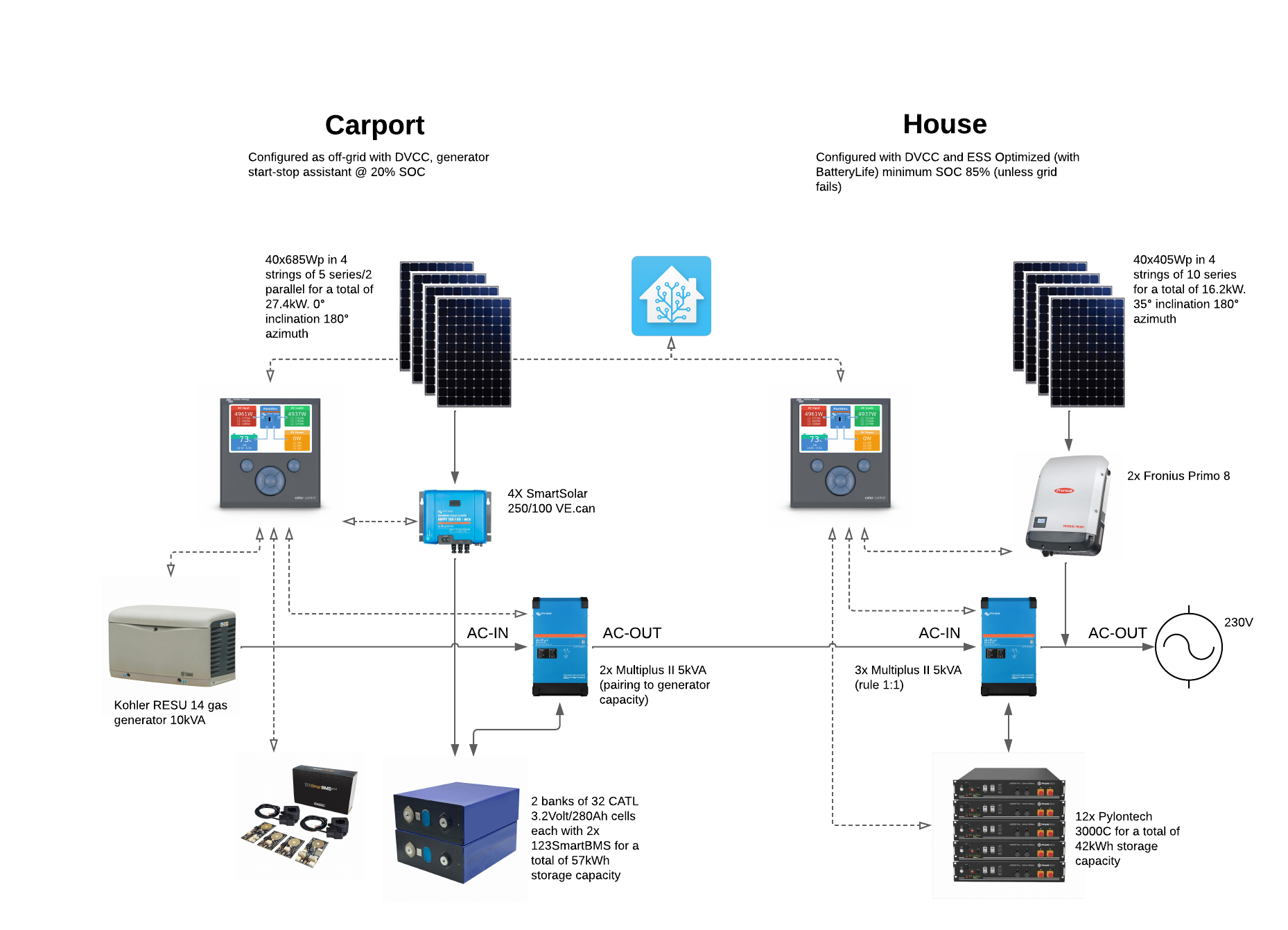There are a number of posts on cascading Multiplus or connecting 2 installations in series. Even though this type of configuration is not officially supported by Victron I wanted to share my experience with the community. Even though this post is not a question I didn't find another better space to post it so here it goes.
I commissioned a first installation 3 years ago for a 100% off-grid new build house in the Valencia region using well tried Fronius/Multiplus II/Pylontech all controlled by CCGX, adding a back-up gas generator. Even though I had what I thought was enough production (16.2kWp) and storage (42kWh) capacity it turned out the generator had to work too many times for too long negating my objective of off-grid independence. There are a number of reasons for this which I could explain in detail but I want to keep the post relatively short. Configuration was relatively straightforward with DVCC enabled and PV inverter + generator start-stop assistants. This installation has been working flawlessly and super-reliable, only downtime caused by external events.
As I still needed to build a carport I investigated the possibility of using it to mount another set of solar panels to feed a second installation. For logistical reasons, the first installation - house - is in the technical room of the house and the second installation - carport - is outside about 10 meters away, I rejected the idea of extending the existing one with solar chargers and more battery capacity as neither the cabling was in place nor did I want to use Pylontech batteries again as I wanted to go for prismatic (cheaper and better use of space).
So I opted for a second independent installation this time using solar chargers (doing away with the inherent risk of AC-coupled only), very large panels 685Wp sourced directly from China (better geometrical fit to cover the carport based on its dimensions and perfect electrical matching to the MPPT chargers) and 2 self-assembled banks of 32 CATL 3.2Volt 280Ah batteries each controlled by 123SmartBMS which interfaces seamlessly with Victron.
The reasoning and configuration was the following:
- New installation, carport, configured with DVCC and off-grid with generator start-stop assistant creating a 230V single-phase grid at AC-OUT. Generator at AC-IN.
- Old installation, house, configured with DVCC and ESS (Optimised with BatteryLife) defining a minimum SOC with grid at AC-IN and PV inverters at AC-OUT
- I know this configuration is not officially supported but there are experiences in the forum I could draw from and, assuming correct installation and configuration, "how could the house installation detect the grid was not a public grid?" and "how could the carport installation detect that it was feeding anything else than another generic consumer?".
The combined installation is now operational for a couple of months and has been working extremely well, never raised an alert or error, is super stable, and after experiencing a particularly rainy month of May meets the expectation of self-consumption independence (no more need for generator except, maybe, extremely long spells of dark days - to be seen).
Points of attention:
- Correct cabling is all the more important and all the do's of Cabling Unlimited should be followed and the dont's, avoided. Of particular importance in my experience is the correct earthing and grounding where loops are really to be avoided (one can easily miss the Multiplus II ground-relay explanation and connect ground to earth elsewhere creating loop)
- Protections, especially RCD have to be carefully designed and here again Cabling Unlimited is of great help
- Fine tuning of the ESS SOC is a matter of trial and error with the objective of balancing the discharge of both systems as well as the charging to avoid "wasting" PV capacity during dark days. Currently it is at 85% but I still need to go through winter season to confirm that and eventually adjust further.
Advantages of a 2-tier cascading installation compared to a single one (IMHO):
- Complete redundancy as each installation can work independently requiring nothing more than a flip of the protection(s)
- Optimisation of architecture as house is AC-coupled hence more efficient during the day when loads (AC only) are higher and carport is DC-coupled thus favouring battery charging which are used mostly during night
- Regulatory and licensing as the house installation remains 15kVA and the carport is nothing more than replacing the generator so no more paperwork
Disadvantages:
- Higher investment in Multiplus II as I had to add another 2 to the carport whereas if I had extended the existing house installation I would only had to add the solar chargers (on the other hand the extra cost was compensated by the DYI battery banks with a cost of 0.21€/Wh (including BMS) compared to at best 0.31€/Wh for the Pylontech)
- Higher complexity (in my view compensated by the redundancy advantage)
Here is a simplified schematic of both installations:

